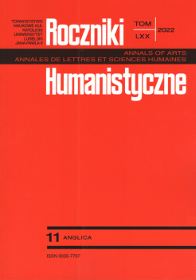Entangled Temporalities of Multiverse Narrative: Life’s Lottery by Kim Newman
Abstract
Drawing on recent developments in unnatural narratology, this paper reads entangled temporalities of Kim Newman’s gamebook novel Life’s Lottery in relation to David Deutsch’s quantum theory of the multiverse. The forking narrative structure of the novel, which allows the reader to influence how a particular storyline will develop by choosing from a set of predetermined options, subverts such commonly assumed characteristics of time as unidirectionality and immutability, and undermines classical narratological models of temporal relations between story and discourse. In Life’s Lottery time constantly branches into contradictory timelines, which not only run in parallel but also crisscross one another and loop upon themselves, thus allowing transition between universes and times. Far from a mere exercise in narrative interactivity, a complex multiverse thus created can be construed as a paradoxically verisimilar representation of life’s contingency.
References
Aarseth, Espen J. Cybertext: Perspectives on Ergodic Literature. Johns Hopkins UP, 1997.
Abbott, H. Porter. The Cambridge Introduction to Narrative. Cambridge UP, 2002.
Alber, Jan. Unnatural Narrative: Impossible Worlds in Fiction and Drama. U of Nebraska P, 2016.
Chatman, Seymour. Story and Discourse: Narrative Structure in Fiction and Film. Cornell UP, 1978.
Deutsch, David. The Fabric of Reality: The Science of Parallel Universes, and its Implications. Penguin, 1998. E-book.
Fludernik, Monika. “Time in Narrative.” Routledge Encyclopedia of Narrative Theory, edited by David Herman et al., Routledge, 2005, pp. 608–12.
Genette, Gerard. Narrative Discourse: An Essay in Method. Translated by Jane E. Lewin, Cornell UP, 1980.
Heinze, Rüdiger. “The Whirligig of Time.” A Poetics of Unnatural Narrative, edited by Jan Alber et al., Ohio State UP, 2013, pp. 31–44.
Herman, David. Basic Elements of Narrative. Wiley-Blackwell, 2012.
Koenitz, Hartmut. “Towards a Specific Theory of Interactive Digital Narrative.” Interactive Digital Narrative: History, Theory, and Practice, edited by Hartmut Koenitz et al., Routledge, 2015, pp. 91–105.
Martínez, María-Ángeles. Storyworld Possible Selves. De Gruyter Mouton, 2018.
Newman, Kim. Life’s Lottery. Titan Books, 2014.
Richardson, Brian. “Beyond Story and Discourse: Narrative Time in Postmodern and Nonmimetic Fiction.” Narrative Dynamics: Essays on Time, Plot, Closure, and Frames, edited by Brian Richardson et al., Ohio State UP, 2002, pp. 47–63.
Rimmon-Kenan, Shlomith. Narrative Fiction: Contemporary Poetics. 2nd ed., Routledge, 2005.
Rubenstein, Mary-Jane. Worlds without End: The Many Lives of the Multiverse. Columbia UP, 2014.
Ryan, Marie-Laure. “From Parallel Universes to Possible Worlds: Ontological Pluralism in Physics, Narratology, and Narrative.” Poetics Today, vol. 27, no. 4, 2006, pp. 633–74.
Ryan, Marie-Laure. Narrative as Virtual Reality: Immersion and Interactivity in Literature and Electronic Media. John Hopkins UP, 2001.
Ryan, Marie-Laure. “Temporal Paradoxes in Narrative.” Style, vol. 43, no. 2, 2009, pp. 142–64.
Salter, Anastasia. What Is Your Quest? From Adventure Games to Interactive Books. U of Iowa P, 2014.
Wake, Paul. “The Unnatural Conventions of the Interactive Gamebook.” Unnatural Narratology: Extensions, Revisions and Challenges, edited by Jan Alber and Brian Richardson, Ohio State UP, 2020, pp. 189–207.
Wardrip-Fruin, Noah. Expressive Processing: Digital Fictions, Computer Games, and Software Studies. MIT Press, 2009.
Copyright (c) 2022 Roczniki Humanistyczne

This work is licensed under a Creative Commons Attribution-NonCommercial-NoDerivatives 4.0 International License.





